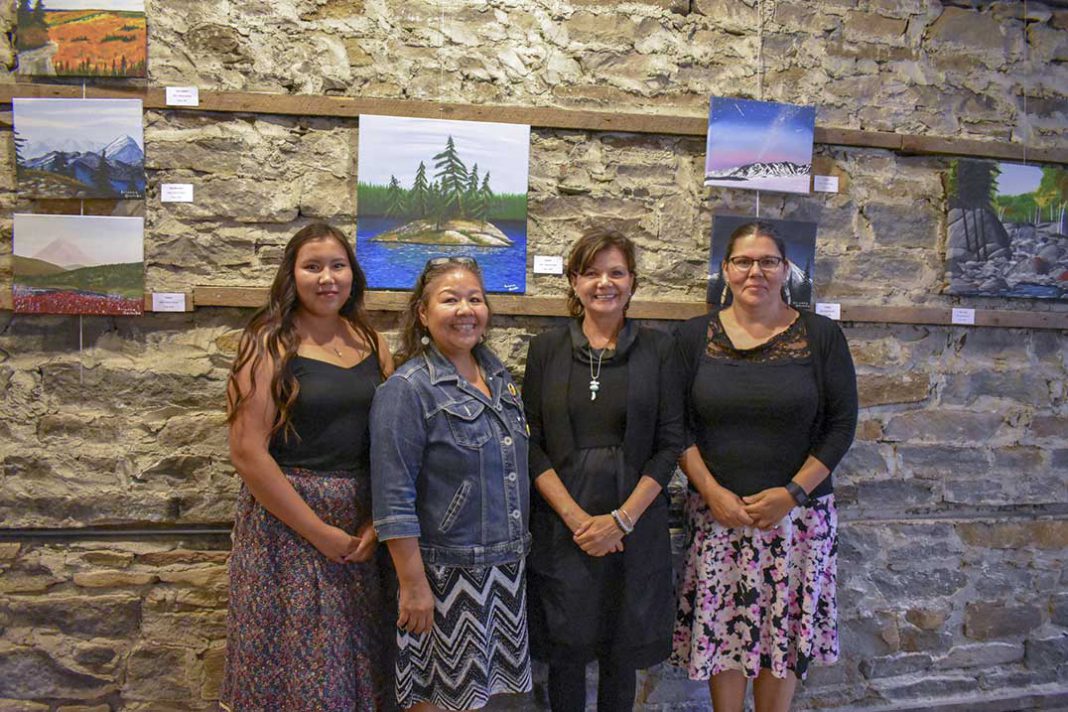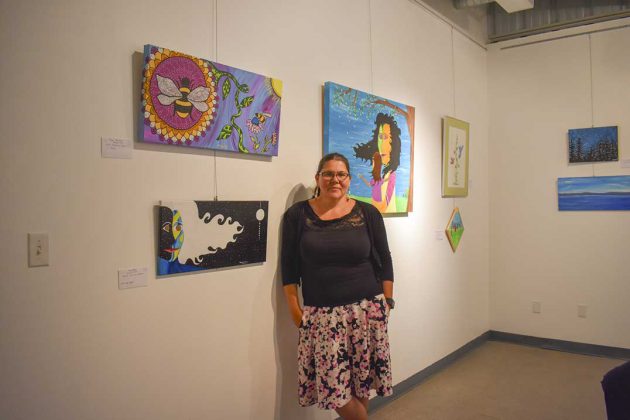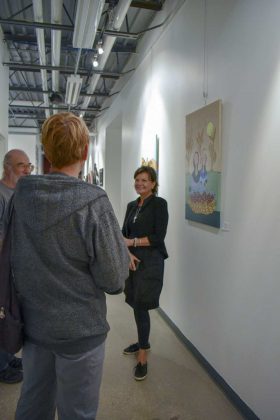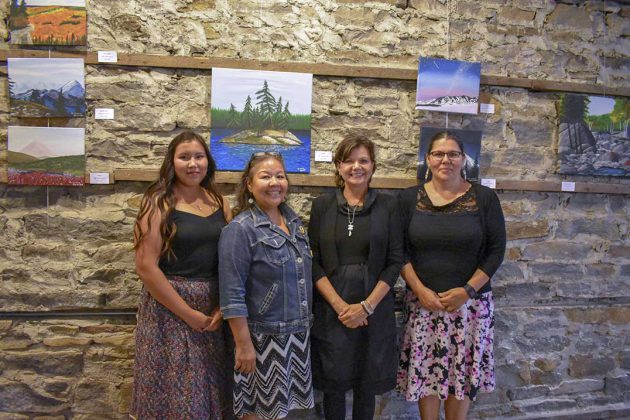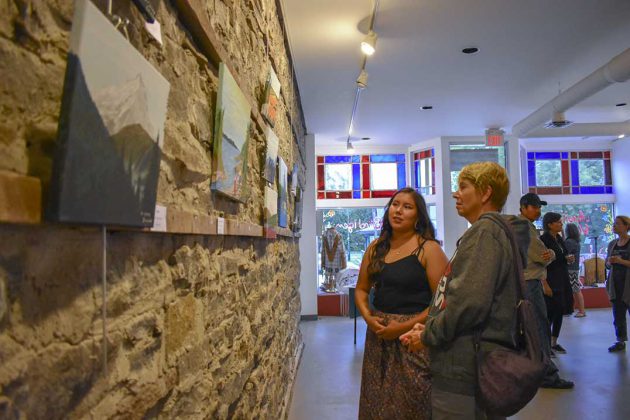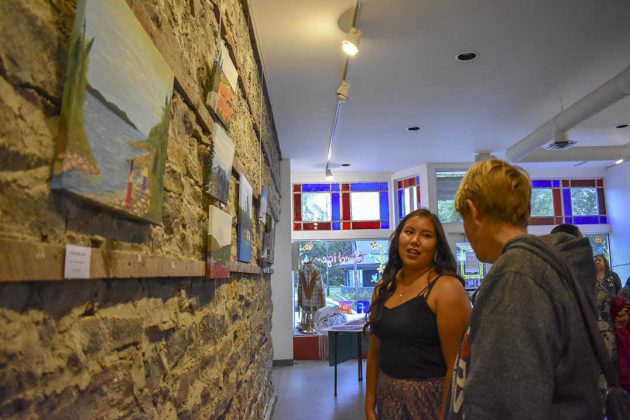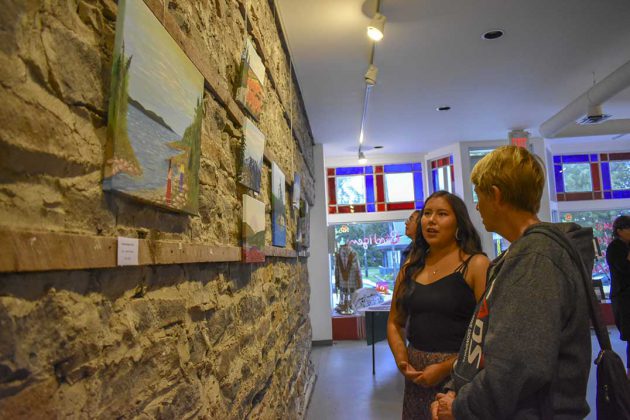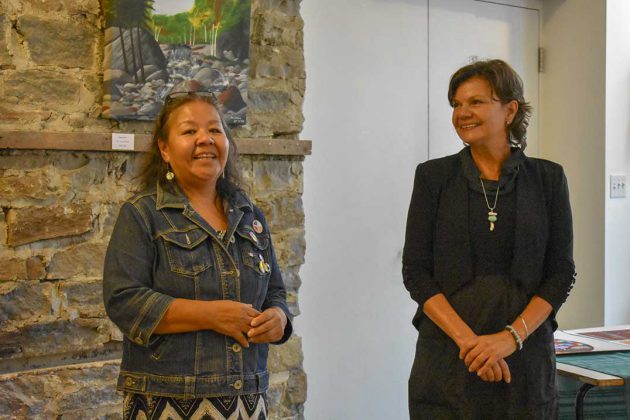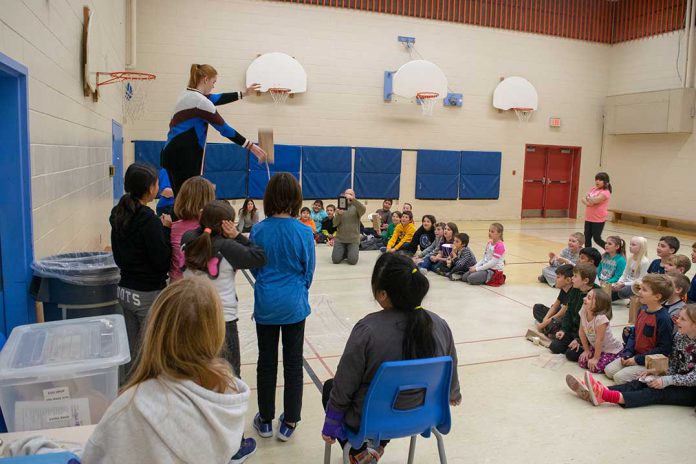MANITOWANING—The Group of Seven Kweok Art Exhibition featured at the K. B. Reynolds Mastin Gallery in the Debajehmujig Creation Centre wrapped up its two-month showing on Saturday, October 27 with a closing reception.
The Group of Seven Kweok is a collaboration of seven experienced, and emerging, Anishinaabe kweok artists including Carrianne Agawa, Santanna J. Eshkawkogan, Sandy Jacko, Heather Manitowabi, R. Nikki Manitowabi, Arianna Ominika and Dolly Peltier.
Prior to this exhibit, R. Nikki Manitowabi, an experienced artist and strong supporter of other artists, first brought the group together for the Manitoulin Art Tour held this past summer in July and then again for the Wiikwemkoong Annual Cultural Festival held in August.
Ms. Manitowabi’s motive in bringing the women together was to provide an opportunity for women artists “to come together to support each other and to create an awareness of the work they do and the stories they share through their art” as well as to showcase “the talent of our young artists.” She adds that the women “were so excited about the exhibit” as a collaboration because as a single artist alone it can be tough to commit to an exhibit.
From hearing about Ms. Manitowabi’s journey as an artist one comes to realize why she feels it’s so important for artists to support each other and in particular, women and young artists.
Ms. Manitowabi began painting at the age of 14 while at a three week-long Ojibwe Cultural Foundation summer art camp held at Rainbow Lodge near Dreamer’s Rock. She reminisces about the camp and the many renowned artists that were involved including Shirley Cheechoo, James Mishibinijima, Randy Trudeau, Martin Panamick, Enoch Jacko, James Jacko, Blake Debassige and John Laford.
She talks about the rich history of Wiikwemkoong artists and how art by local artists, including Daphne Odjig, has always been in the community. In the schools, local artists taught classes, works by Anishinaabe artists hung in the halls and could be found in books, all of which really helped to foster the encouragement of young artists.
While in school and as a young mother, she continued to paint but was more focussed on school and working towards a university education and raising her children. Now, however, she says as she’s gotten older and has more time to paint, her art is continuing to develop and is becoming more vibrant and bolder in colour, which she feels “speaks more to confidence” as an artist.
Ms. Manitowabi loves painting, which she likens to meditation. She takes inspiration from family, relationships, cultural teachings of the Anishinaabekwe and their responsibilities in the community. She says that what she “sees the women doing is really inspiring” and that, when someone tells her a story about a woman, her responsibilities, or a teaching, she wants to paint that story and that is how she started painting more about what goes on in her community.
She believes a lot of the women have stories to tell and that’s what they’re doing through their art and says that “as women, we’re documenting some of those teachings to pass on to our children” and that “having the show, and bringing other women together to support them, much like the way I was supported when I was a young artist, is really enriching.”
Helping and supporting each other is beneficial for all and especially for the young emerging artists, whom she felt were important to include in the exhibit in order to support and encourage them while also fostering “the mechanism for them to market and show their work” and at the same time showing a wider audience that Wiikwemkoong is rich with artists.
Ms. Manitowabi is very proud of the exhibit and the other Anishinaabekweok in the exhibit and speaks highly of each of the women and their art, which she is obviously impressed with and moved by.
She had previously worked with Carrianne Agawa while helping to organize another exhibit in southern Ontario, which made it natural to include her in the Manitoulin Art Tour. Ms. Agawa’s sister Sandy Jacko, an artist as well, was also encouraged to become part of the art tour as was Heather Manitowabi and Dolly Peltier, both of whom Ms. Manitowabi had known for many years. Santanna J. Eshkawkogan and Arianna Ominika, the two youngest artists in the group, were also invited to become a part of the collaboration not only because Ms. Manitowabi felt that it was important to include young emerging artists but also because their artwork is “so beautiful and people need to see their work.”
The youngest of the group is 19-year-old Arianna Ominika who’s been an avid painter since discovering her hidden talent in a high school art class. Despite having only been painting for two years, Ms. Ominika’s landscape paintings, inspired by Bob Ross who she counts among her influences, are incredibly intricate and detailed.
Ms. Ominika has been inspired by artists in her family including her late uncle Randy Trudeau and her late auntie Karen Manitowabi who taught her “a lot about different things and lessons growing up.” She describes a wonderful feeling that she has when she is painting, which is when she will often think of her auntie and her uncle and feel comfort knowing that she shares their talent for painting. She just wishes they were still around to see her artwork.
Ms. Ominika holds ‘A Water Walker’s Path,’ one of her favourite paintings in the exhibit, close to her heart as it reminds her of her late auntie Karen Manitowabi who started the annual water walk in her community of Wiikwemkoong. Ms. Ominika’s been on a few of the water walks herself and was moved and inspired by the scenery and looks forward to painting more pieces like this one.
As a new exhibitor she has found the whole experience “exciting and a little nerve-racking, but mostly exciting,” especially since she is now sharing her artwork with a wider audience beyond family and friends. Being a part of the exhibit means a lot to her and she considers it to be a wonderful opportunity that she is thankful for.
Ms. Ominika hopes to enroll into an art program at OCAD university someday in the future, but for now just wants to paint as much as she can to fill her walls at home with artwork, which she admits she has been missing while her art has been hanging on the walls of the K. B. Reynolds Mastin Gallery.
One of the more experienced artists in the group, Ms. Agawa, who describes her art style as “Ojibwe traditional woodland from a feminist perspective,” has been painting since she was about seven-years-old when her mother would buy her oil-based paint by number kits to paint.
Ms. Agawa describes herself as “a contrary—what is known as a windigo kaan” and sees part of her role as showing “other sides to what seems only one way” which is evidenced by the beings portrayed in her art work, which have more than one face. She aims “to tell a story from multiple perspectives” which she believes is important “so we can grow in a more holistic manner.”
Ms. Agawa aspires to tell the stories that she grew up with and the ones that she has learned over the years, as well as to empower Anishinaabe people through her art and stories. She believes that utilizing other mediums such as art to help others find their voice is important in creating positive change.
A multi-talented artist, Ms. Agawa has been selling her work for over 25 years, which she credits with helping her get through an undergraduate degree and a Masters in Education. While she works mainly in watercolour and acrylics, she does other artwork including beading, sewing and leatherwork.
Encouraged by Zoe Wood-Salomon to do juried exhibits, Ms. Agawa started exhibiting in Sault Ste. Marie around 2002 and won an award her second year of exhibiting. She continues to exhibit when she is inspired by opportunities that present themselves.
Ms. Agawa is grateful to be part of the Group of Seven Kweok exhibition and considers exhibiting alongside her sister a bonus. She appreciates the opportunity the exhibit has provided the kweok to tell their stories. She says, “we are all storytellers telling our stories through the eyes of kweok and that is powerful.” She adds that, through the exhibit, the seven kweok are laying foundation work for other women to see their strengths. She makes special mention of how she appreciates “Nikki’s ability to encourage others to be part of something that highlights women.”
The other kweok included Santanna J. Eshkawkogan, who had a number of mixed media pieces in the exhibit; Sandy Jacko, who had a number of paintings in the exhibit; Heather Manitowabi, 2012 recipient of the Premier’s Award for Excellence in the Arts – Emerging Artist of the Year had her painting ‘Niin Na Miinwaa?’ (Am I Next?) in the exhibit, which aims to bring awareness to the Missing and Murdered Indigenous Women on Turtle Island; and multi-disciplinary artist Dolly Peltier had a number of her mixed media pieces on display as well.
Barry Beaver, visual artist in residence for the Debajehmujig Creation Centre, says “it’s been a strong year for our exhibits and the re-opening of the gallery” and lauds the Group of Seven Kweok Art Exhibition as being an important part of the Centre’s 2018 focus on the empowerment of women.
As for future plans, Ms. Manitowabi hints at the possibility of the exhibit becoming an annual event. She described the Group of Seven Kweok exhibit as a positive experience and the participating kweok as talented artists who support each other. She expressed gratitude for the opportunity to show the women’s work at Debajehmujig and believes it was a good venue to get the word out about the work the women do and that the exhibit itself has shown that “our culture is evolving and so are our artists.”

